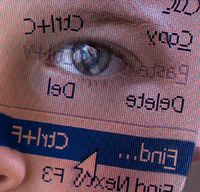Difference between revisions of "Superimposition"
m (moved Superimposed to Superimposition) |
m (Text replacement - "http://" to "https://") |
||
| Line 1: | Line 1: | ||
[[File:lighterstill.jpg]][[File:Superimposition.jpg|right|frame]] | [[File:lighterstill.jpg]][[File:Superimposition.jpg|right|frame]] | ||
| − | *Date: [ | + | *Date: [https://www.wikipedia.org/wiki/18th_Century 1794] |
==Definition== | ==Definition== | ||
*to place or lay over or above something <superimposed images> | *to place or lay over or above something <superimposed images> | ||
| Line 7: | Line 7: | ||
In graphics, '''superimposition''' is the placement of an image or video on top of an already-existing image or video, usually to add to the overall image [[effect]], but also sometimes to conceal something (such as when a [[different]] face is superimposed over the [[original]] face in a photograph). | In graphics, '''superimposition''' is the placement of an image or video on top of an already-existing image or video, usually to add to the overall image [[effect]], but also sometimes to conceal something (such as when a [[different]] face is superimposed over the [[original]] face in a photograph). | ||
| − | This [[technique]] is used in [ | + | This [[technique]] is used in [https://www.wikipedia.org/wiki/Cartography cartography] to produce photomaps by superimposing grid lines, contour lines and other [[linear]] or [[textual]] mapping features over aerial photographs. |
| − | Superimposition of 2D images containing correlated periodic grid structures may produce [ | + | Superimposition of 2D images containing correlated periodic grid structures may produce [https://en.wikipedia.org/wiki/Moir%C3%A9_pattern moiré patterns]. Superimposition of two correlated layers comprising [[parallel]] lines or curves may give rise [https://en.wikipedia.org/wiki/Line_moir%C3%A9 line moiré] patterns. The movement of one of the layers results in a faster movement of the line moiré superimposition image. Such optical acceleration is known as [https://en.wikipedia.org/wiki/Moir%C3%A9_speedup moiré speedup] (check for the [[formula]]s of optical speedup for curved patterns). When superimposing two identical layers comprising [[random]]ly spaced [[parallel]] lines, at a small angle or with a small scaling [[difference]] [https://switzernet.com/people/emin-gabrielyan/070227-random-line-moire/ random line moiré] patterns, namely line Glass patterns (after Leon Glass, 1969) appear. Similarly, when superimposing two identical layers of randomly scattered dots at a small angle or with a small scaling difference random dot Glass patterns, namely [https://switzernet.com/people/emin-gabrielyan/070212-random-moire/ random dot moiré], appears. When one of the layers embeds [[complex]] shapes, such as [[sequences]] of [[symbols]] forming a [[text]], and another layer contains parallel lines or curves, the superimposition image may give rise to magnified shapes, called [https://en.wikipedia.org/wiki/Shape_moir%C3%A9 shape moiré patterns]. |
[[Category: The Arts]] | [[Category: The Arts]] | ||
Latest revision as of 02:32, 13 December 2020
- Date: 1794
Definition
- to place or lay over or above something <superimposed images>
Description
In graphics, superimposition is the placement of an image or video on top of an already-existing image or video, usually to add to the overall image effect, but also sometimes to conceal something (such as when a different face is superimposed over the original face in a photograph).
This technique is used in cartography to produce photomaps by superimposing grid lines, contour lines and other linear or textual mapping features over aerial photographs.
Superimposition of 2D images containing correlated periodic grid structures may produce moiré patterns. Superimposition of two correlated layers comprising parallel lines or curves may give rise line moiré patterns. The movement of one of the layers results in a faster movement of the line moiré superimposition image. Such optical acceleration is known as moiré speedup (check for the formulas of optical speedup for curved patterns). When superimposing two identical layers comprising randomly spaced parallel lines, at a small angle or with a small scaling difference random line moiré patterns, namely line Glass patterns (after Leon Glass, 1969) appear. Similarly, when superimposing two identical layers of randomly scattered dots at a small angle or with a small scaling difference random dot Glass patterns, namely random dot moiré, appears. When one of the layers embeds complex shapes, such as sequences of symbols forming a text, and another layer contains parallel lines or curves, the superimposition image may give rise to magnified shapes, called shape moiré patterns.
